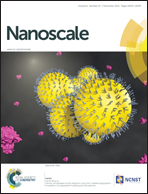Reversible formation of Ag44 from selenolates†
Abstract
The cluster Ag44SePh30, originally prepared from silver selenolate, upon oxidative decomposition by H2O2 gives the same cluster back, in an apparently reversible synthesis. Such an unusual phenomenon was not seen for the corresponding thiolate analogues. From several characterization studies such as mass spectrometry, Raman spectroscopy, etc., it has been confirmed that the degraded and as-synthesized selenolates are the same in nature, which leads to the reversible process. The possibility of making clusters from the degraded material makes cluster synthesis economical. This observation makes one to consider cluster synthesis to be a reversible chemical process, at least for selenolates.


 Please wait while we load your content...
Please wait while we load your content...